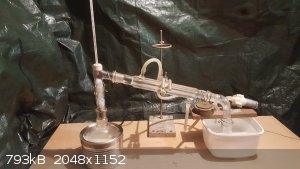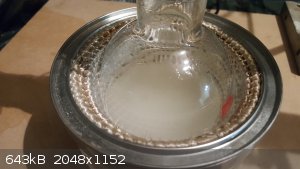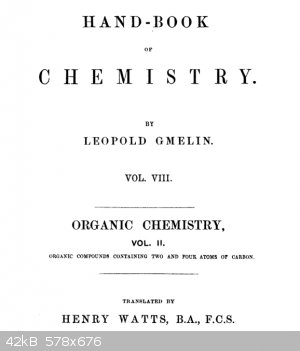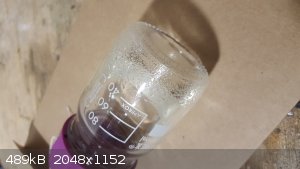| Pages:
1
..
14
15
16
17
18
..
20 |
Hawkguy
Hazard to Others
  
Posts: 326
Registered: 10-10-2014
Location: British Columbia (Canada eh!)
Member Is Offline
Mood: Body is Ready
|
|
Quote: Originally posted by nux vomica  | Quote: Originally posted by Hawkguy  | Quote: Originally posted by nux vomica  | | Yes its a mix of unreacted ethanol and acetaldehyde, I collect the distillate that comes off below 60° c but it would be better to know the % of
acetaldehyde in the solution so I can calculate how much to collect , and to check purity of the final product. |
Try making paraldehyde and measuring it that way |
I will have to look into that method, as I already use the sodium sulfide method with my formaldehyde solutions I was hoping it wold work with
acetaldehyde as well. |
What's nice about doing it this way is that you lose no product during the testing.
|
|
|
nux vomica
Hazard to Others
  
Posts: 267
Registered: 18-7-2013
Member Is Offline
Mood: No Mood
|
|
I ran another batch last night and ended up with 60mls of acetaldehyde ethanol mix I will try your suggestion if I can tonight thanks nux.
|
|
|
Daffodile
Hazard to Others
  
Posts: 167
Registered: 7-3-2016
Location: Highways of Valhalla
Member Is Offline
Mood: Riding eternal
|
|
Huh I found a patent that said Acetaldehyde can be prepared by dry distilling/ pyrolyzing Barium Formate. Might be interestng to anyone looking for
alternate routes to such a product.
EDIT: I'm reading old SM threads on the topic, and I can't get a consistent answer, some say the pyrolysis produces Acetone or Formaldehyde.
[Edited on 10-3-2016 by Daffodile]
|
|
|
clearly_not_atara
International Hazard
    
Posts: 2692
Registered: 3-11-2013
Member Is Offline
Mood: Big
|
|
Both quotes from page 2:
| Quote: | When you boil pyruvic acid with diluted H2SO4 you get acetaldehyde boiling out of the reaction.
Pyruvic acid is easily prepared from sodium pyruvate available over the net (unsuspicious not so expensive) or at the healthstore (expensive).
Stochiometric amounts of HCl should do the trick I guess. |
| Quote: | | the condensed chemical dictionary states that pyruvic acid is derivated by dehydration of tartaric acid by distilling with potassium acid sulfate so
both decarboxilation and pinacol rearrangement happen in this reaction. |
Both from page 2. I noticed that the mechanisms of these reactions are all acid-catalyzed, and in fact are all catalyzed by H2SO4. Tartrate undergoes
a pinacol rearrangement to oxaloacetate, which decarboxylates to pyruvate, which decarboxylates to acetaldehyde. Why not simply heat tartaric acid in
sulfuric acid?
|
|
|
clearly_not_atara
International Hazard
    
Posts: 2692
Registered: 3-11-2013
Member Is Offline
Mood: Big
|
|
http://www.organic-chemistry.org/abstracts/lit3/684.shtm
Selective, aerobic, uses catalytic 4-hydroxy-TEMPO, ferric nitrate, sodium chloride, and silica. Would've edited this into my last post but I can't
and this reaction looks frankly amazing from an atom economy and safety standpoint.
[Edited on 28-3-2016 by clearly_not_atara]
|
|
|
nux vomica
Hazard to Others
  
Posts: 267
Registered: 18-7-2013
Member Is Offline
Mood: No Mood
|
|
Link to youtube video https://youtu.be/7XNoWUeWxIk
|
|
|
Magpie
lab constructor
    
Posts: 5939
Registered: 1-11-2003
Location: USA
Member Is Offline
Mood: Chemistry: the subtle science.
|
|
Nice going nux! Please give us the details on this preparation including purification and the yield.
I love seeing use of the peristaltic pump, and have noted your fine homemade mantle. 
Also, did you make those joint clips? I want some of those for high-temperature reactions. What kind of wire did you use? Anything special or just
coat hanger wire?
[Edited on 13-9-2016 by Magpie]
The single most important condition for a successful synthesis is good mixing - Nicodem
|
|
|
nux vomica
Hazard to Others
  
Posts: 267
Registered: 18-7-2013
Member Is Offline
Mood: No Mood
|
|
Quote: Originally posted by Magpie  | Nice going nux! Please give us the details on this preparation including purification and the yield.
I love seeing use of the peristaltic pump, and have noted your fine homemade mantle. 
Also, did you make those joint clips? I want some of those for high-temperature reactions. What kind of wire did you use? Anything special or just
coat hanger wire?
[Edited on 13-9-2016 by Magpie] |
Thanks magpie i am going to do some more work on the purification tonight so i can post some more info .
I find i use the peristaltic pump more than a dropping funnel as long as the silicon tube can take the liquid flowing through it.
I got the clips off ebay after the plastic ones kept melting or cracking.
[Edited on 13-9-2016 by nux vomica]
|
|
|
Magpie
lab constructor
    
Posts: 5939
Registered: 1-11-2003
Location: USA
Member Is Offline
Mood: Chemistry: the subtle science.
|
|
Quote: Originally posted by nux vomica  |
I find i use the peristaltic pump more than a dropping funnel as long as the silicon tube can take the liquid flowing through it.
|
I replaced the silicone tubing with a smaller PVC (Tygon) tubing. It works just as well or better as the ID is smaller.
I tried to make those out of coat hanger wire but it is too stiff.
The single most important condition for a successful synthesis is good mixing - Nicodem
|
|
|
nux vomica
Hazard to Others
  
Posts: 267
Registered: 18-7-2013
Member Is Offline
Mood: No Mood
|
|
Ive uploaded another video showing the purification of the acetaldehyde and the yield.
https://youtu.be/-x_lMokdjxk


|
|
|
Magpie
lab constructor
    
Posts: 5939
Registered: 1-11-2003
Location: USA
Member Is Offline
Mood: Chemistry: the subtle science.
|
|
Very nice. I like the simplicity. Does the CaCl2 absorb water? Are azeotropes a concern? Did you have a lot of bumping?
I have tried that method for making butyraldehyde and propionaldehyde without much success(per Brewster). But CaCl2 was not used.
I will definitely be trying this.
The single most important condition for a successful synthesis is good mixing - Nicodem
|
|
|
nux vomica
Hazard to Others
  
Posts: 267
Registered: 18-7-2013
Member Is Offline
Mood: No Mood
|
|
Quote: Originally posted by Magpie  | Very nice. I like the simplicity. Does the CaCl2 absorb water? Are azeotropes a concern? Did you have a lot of bumping?
I have tried that method for making butyraldehyde and propionaldehyde without much success(per Brewster). But CaCl2 was not used.
I will definitely be trying this. |
thanks magpie I got the information out of a book on google books
 
The calcium absorbs the water and seem to smooth the boiling out.
As I understand it there isn't a azeotrope with water or ethanol so separation is reasonably straight forward.
Cheers nux.
|
|
|
nux vomica
Hazard to Others
  
Posts: 267
Registered: 18-7-2013
Member Is Offline
Mood: No Mood
|
|
I found a intresting occurrence happening in the storage bottle that my Acetaldehyde is kept in, there seems to be crystals of some sort forming on
the walls of the bottle , i can only presume that metedehyde is forming and i wonder if a tiny amount of Sulfuric Acid has somehow contaminated the
bottle and has catalysed some of the Acetaldehyde.

|
|
|
clearly_not_atara
International Hazard
    
Posts: 2692
Registered: 3-11-2013
Member Is Offline
Mood: Big
|
|
Found this by accident, no really:
https://books.google.com/books?id=Cbc2AAAAQBAJ&pg=PT1830...
| Quote: | | Oxidation of alcohols with NaOCl can also be performed in the absence of nitrosyl radicals or a transition metal by the addition of certain promoters
such as phase transfer catalysts, beta-cyclodextrin, or the use of an ionic liquid as solvent. The PTC/NaOCl protocol has emerged as the most
convenient method of choice. A distinct advantage of the PTC/NaOCl protocol relative to the NaOCl/AcOH procedure is the ability to oxidize primary
alcohols to aldehydes with minimal overoxidation to the ester, and the ability to oxidize alcohol substrates selectively in the presence of double
bonds. In addition the PTC conditions do not require the use of chlorinated solvents and often afford fast rates of reaction at ambient temperature.
|
It appears that the likely mechanism of the hypochlorite/PTC oxidation is the electrophilic addition of the alcohol to hypochlorite ion:
RCH2OH + OCl- >> OH- + RCH2OCl (slow)
This is deprotonated by hydroxide, which is extremely basic in aprotic solvents:
RCH2OCl + OH- >> RCHOCl- + H2O (fast) [solvent cage effect]
and eliminates chloride:
RCHOCl- >> RCHO + Cl- (fast)
The aldehyde doesn't react further because this intermediate forms:
RCHO + OCl- >> RCH(OCl)O-
which is both much less acidic (negatively charged) and does not generate free hydroxide ion, so the elimination of HCl to form RCO2- is much less
favorable.
Examples:
1-octanol + NaOCl [EtOAc/H2O, Bu4NBr] >> 1-octanal (86%)
15-desmethyl-cholesterol + NaOCl [EtOAc/H2O, Bu4NBr] >> 15-desmethyl-cholesterone (72%)
http://www.sciencedirect.com/science/article/pii/S0040403998...
Another version is catalyzed by cyclodextrin (Febreze) and occurs in water:
cinnamyl alcohol + NaOCl [beta-cyclodextrin, water] >> cinnamaldehyde (99%)
The cyclodextrin procedure may be more appropriate for ethanol, actually.
[Edited on 17-11-2016 by clearly_not_atara]
|
|
|
tsathoggua1
Hazard to Others
  
Posts: 335
Registered: 8-1-2017
Location: Beyond the pale
Member Is Offline
Mood: Phosphorescent
|
|
Here is a thought
The tetramer of acetaldehyde is readily available. Metaldehyde is the tetramer, paraldehyde the trimer (nasty shit, really, really nasty stuff, its in
some of my physician's books dating back from the 1700s as a sedative-hypnotic. My advice is not to try it, you will thank yourself. Its awful in
vivo, it stinks and it eats some plastics, not sure which will resist it, but like chlormethiazole, its quite aggressive towards plastics vulnerable
to it)
Metaldehyde is the active ingredient in slug pellets. Slugs ingest or absorb it through skin contact and its transformed in vivo to acetaldehyde which
poisons the molluscs in question.
Two ideas-attempting depolymerization with either conc. or dilute sulfuric acid. Or thermal depolymerization. I'll give it a try, since I've a large
tub of slug pellets in the lab courtesy of meaning to try exactly that. I won't use them on the garden, since it would poison other creatures eating
the dead slug/snails, and in any case, I'd sooner they eat the plants than kill them.
First, I'll try a simple thermal depolymerization of powdered slug pellets in an alembic leading any vapours into an ice-diethylene glycol/CaCl2 bath
cooled collection vessel and see what happens. If no luck, then will try addition of a little sulfuric. Anybody know if acetaldehyde attacks plastics?
Should be easy to separate acetaldehyde from any paralydehyde, since the BP of the latter is 124'C
|
|
|
PHILOU Zrealone
International Hazard
    
Posts: 2893
Registered: 20-5-2002
Location: Brussel
Member Is Offline
Mood: Bis-diazo-dinitro-hydroquinonic
|
|
Quote: Originally posted by tsathoggua1  | Here is a thought
The tetramer of acetaldehyde is readily available. Metaldehyde is the tetramer, paraldehyde the trimer (nasty shit, really, really nasty stuff, its in
some of my physician's books dating back from the 1700s as a sedative-hypnotic. My advice is not to try it, you will thank yourself. Its awful in
vivo, it stinks and it eats some plastics, not sure which will resist it, but like chlormethiazole, its quite aggressive towards plastics vulnerable
to it)
Metaldehyde is the active ingredient in slug pellets. Slugs ingest or absorb it through skin contact and its transformed in vivo to acetaldehyde which
poisons the molluscs in question.
Two ideas-attempting depolymerization with either conc. or dilute sulfuric acid. Or thermal depolymerization. I'll give it a try, since I've a large
tub of slug pellets in the lab courtesy of meaning to try exactly that. I won't use them on the garden, since it would poison other creatures eating
the dead slug/snails, and in any case, I'd sooner they eat the plants than kill them.
First, I'll try a simple thermal depolymerization of powdered slug pellets in an alembic leading any vapours into an ice-diethylene glycol/CaCl2 bath
cooled collection vessel and see what happens. If no luck, then will try addition of a little sulfuric. Anybody know if acetaldehyde attacks plastics?
Should be easy to separate acetaldehyde from any paralydehyde, since the BP of the latter is 124'C |
How much % metaldehyde are present into your pellets?
Here in Belgium the % is relatively low (5-12%)...in the past (20-25 years ago) the % was much higher and that route to obtain ethanal was viable. Why
the % reduction? Probably thanks to Europe régulations to fight against poisoning and toxic casualities of humans and animals.
Now with such a low % it is probably better to start from ethanol.
[Edited on 19-2-2017 by PHILOU Zrealone]
PH Z (PHILOU Zrealone)
"Physic is all what never works; Chemistry is all what stinks and explodes!"-"Life that deadly disease, sexually transmitted."(W.Allen)
|
|
|
tsathoggua1
Hazard to Others
  
Posts: 335
Registered: 8-1-2017
Location: Beyond the pale
Member Is Offline
Mood: Phosphorescent
|
|
Fucking politicians. IMO someone needs to come up with 'politician pellets' that can be scattered around where such vermin congregate and off them. At
least there would be little collateral damage, given politicians aren't generally a wildlife menu item.
I just grabbed the slug pellets. 3%. Pretty measly, but the container is full more or less, not sure if any have been used but either totally or
almost full. I had a go at my old man once and told him to stop putting slug pellets down because of the hedgehogs that are likely to eat the
poisonous slugs.
And we do have them round here, I've seen them snuffling around at night. Cute as hell they are, if caught gently in the hands, the distribution of
spines is too wide to do damage unless someone were to badly handle them. After a while they start getting a little more trusting and uncurl, start
snuffling at your hands.
I took one in years ago too, just a baby, found it in a back alley with winter coming on, there was no way it would have survived hibernation since it
was too thin and scrawny. Kept it over winter, fed it up and eventually, released a nicely plump, well-fed fighting fit hedgehog.
I'll try roasting some of those slug pellets, ground up with a little H2SO4 added.
Question-concentration of H2SO4? I have 98% should conc. sulfuric be used or should it be diluted first? and is heating actually necessary?
|
|
|
PHILOU Zrealone
International Hazard
    
Posts: 2893
Registered: 20-5-2002
Location: Brussel
Member Is Offline
Mood: Bis-diazo-dinitro-hydroquinonic
|
|
Hedgehogs, yes cute and usefull as insect-eaters.
I had also one once a few days...but those are night/nocturne animals...and it was doing such a noise at night that it woke the neightbourgs up....so
I set it free quite fast afterwards.
If it is for hydrolysis...there is no need to use too concentrated acid...the acid is a catalyst but the reactant is the water...so without water...it
won't work.
Now the real problem is to know what are the 88-97% remaining material...is it compatible with H2SO4, has it a value, on its own or as a derivative...
Maybe you could work on an extraction first...to increase the %...owing to the cyclic ether (acetal) nature of the tetramer...it must be soluble in
organic solvents...like benzen or chlorofom...of course if the rest of the material is not soluble into the solvent too.
PH Z (PHILOU Zrealone)
"Physic is all what never works; Chemistry is all what stinks and explodes!"-"Life that deadly disease, sexually transmitted."(W.Allen)
|
|
|
tsathoggua1
Hazard to Others
  
Posts: 335
Registered: 8-1-2017
Location: Beyond the pale
Member Is Offline
Mood: Phosphorescent
|
|
I was thinking keep it simple, and do a destructive distillation on the powdered pellets, soaked in a little sulfuric.
|
|
|
PHILOU Zrealone
International Hazard
    
Posts: 2893
Registered: 20-5-2002
Location: Brussel
Member Is Offline
Mood: Bis-diazo-dinitro-hydroquinonic
|
|
Try in small quantity first...and see if it works...
Such a test is cheap and fast...so I would say go for it    
I also have bought the product and stocked some at home just in case a few years ago...too bad I didn't did this before the % reduction  . .
[Edited on 19-2-2017 by PHILOU Zrealone]
PH Z (PHILOU Zrealone)
"Physic is all what never works; Chemistry is all what stinks and explodes!"-"Life that deadly disease, sexually transmitted."(W.Allen)
|
|
|
unionised
International Hazard
    
Posts: 5102
Registered: 1-11-2003
Location: UK
Member Is Offline
Mood: No Mood
|
|
Slug pellets and dilute sulphuric acid might turn out to be a better synthesis of furfural than ethanal.
|
|
|
PHILOU Zrealone
International Hazard
    
Posts: 2893
Registered: 20-5-2002
Location: Brussel
Member Is Offline
Mood: Bis-diazo-dinitro-hydroquinonic
|
|
Why? Because of the 88-97% remaining unknown material? Is it a pentose/hexose (cellulose or polyose) related material?
PH Z (PHILOU Zrealone)
"Physic is all what never works; Chemistry is all what stinks and explodes!"-"Life that deadly disease, sexually transmitted."(W.Allen)
|
|
|
tsathoggua1
Hazard to Others
  
Posts: 335
Registered: 8-1-2017
Location: Beyond the pale
Member Is Offline
Mood: Phosphorescent
|
|
Cheap? more or less free since I already have the sulfuric, and the the pellets were bought by my old man for killing slugs. I took them, just in case
he got tempted to use them, because of the effect on wildlife in part (I am very much an animal lover, and indeed I'd even side with the slugs rather
than kill them, I'd just catch them and move them to the garden of somebody I didn't like. And if I see snails in the street when I'm out I'll stop to
pick them up and place them at the side of the street or on a garden fence assuming its not sunny and hot. If it is, I put them in the shade under
someone's garden plants; to avoid those in the middle of the street being trodden on accidentally, or deliberately for that matter and crushed)
And partly because a lot of me was looking at the jar of pellets and thinking...hmm bet that tetramer of acetaldehyde can be depolymerized and some
acetaldehyde had from it!
I don't know what the slug pellet base is,, the bulk filler I mean. I'll give it a crack now once I've finished my smoke and had my morning dose of
morphine, chlormethiazole, clonidine, tizanidine and additional oxy.
Edit-slight delay, need to find a spare mains plug for my water pump for the condenser. Also, checking, also found another half to 3/4 full pack of
metaldehyde slug pellets, although they are metaldehyde based it doesn't say what percentage is in them or what the base material is either. Plus as a
bonus another full pack, but not metaldehyde, ferric phosphate. Which presumably in the anhydrous state is a lewis acid and could be dehydrated using
P2O5 as a slurry in some suitable solvent of choice?
[Edited on 20-2-2017 by tsathoggua1]
|
|
|
Magpie
lab constructor
    
Posts: 5939
Registered: 1-11-2003
Location: USA
Member Is Offline
Mood: Chemistry: the subtle science.
|
|
Acetaldehyde by pinacol rearrangement?
Does anyone know if acetaldehyde can be made by the pinacol rearrangement of ethylene glycol. If so, would it be practical for the home chemist?
The single most important condition for a successful synthesis is good mixing - Nicodem
|
|
|
byko3y
National Hazard
   
Posts: 721
Registered: 16-3-2015
Member Is Offline
Mood: dooM
|
|
https://dx.doi.org/10.1016/S0040-4020(02)00103-5 - Ethylene glycol to acetaldehyde-dehydration or a concerted mechanism
https://dx.doi.org/10.1002/(SICI)1099-1395(199910)12:10%3C74... - Hydrogen as a migrating group in some pinacol rearrangements: a DFT study
I have no double the reaction is possible, but I have no idea how to perform it. The only thing I'm sure is that you can't get acetaldehyde by heating
ethylene glycol in a dillute sulfuric acid.
|
|
|
| Pages:
1
..
14
15
16
17
18
..
20 |